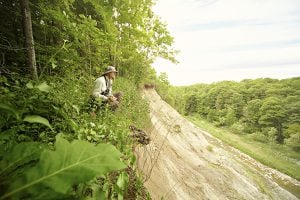Qausuittuq, Canada’s newest national park, is a haven for endangered Peary caribou. (Photo: Marlis Butcher)
Peary caribou are small compared to their southern cousins, the woodland and tundra caribou. Their petite stature belies their hardiness and ability to cope with the harsh Arctic environment. Summer temperatures top out at around 5°C in this polar desert, and the landscape consists mostly of small rocks and dried mud flats with only sparse patches of lichens and mosses — not much for vegetarians like the caribou to live on.
We heaved on our heavy backpacks and hiked out of the gravelly plain on which we had landed. We slogged through shallow muck on the edges of the valley, and onto higher, drier ground. We set up camp near a clear-running stream, in a pretty field of yellow Arctic poppies. To be precise, the poppies grew through the cracks of a dried mud plain, each plant blooming a few feet away from its neighbour. However, in a place so seemingly devoid of life, a plateau dotted with bobbing colour was a major attraction.
The low, rounded mountains of the Stokes Range rose up around our camp. From a distance they looked like gentle, easy-to-climb hills, but as we climbed up one 350-metre rise, we discovered that the hills were strewn with huge flat boulders interspersed with jumbles of sharp-edged rocks that threatened us with cuts and sprains. There were patches of shale shards which slid out from under our feet, and sand blowouts in which we found chunks of clear quartz. A few patches of snow still clung stubbornly to the shady side of rocky alcoves; we wondered whether these remnants of last winter would melt before the end of this summer.
From the top of the mountain we looked out over park. The other valleys between the Stokes Mountains looked just as broad and barren as the one we were camped in. In the distance, the Arctic Ocean was filled with broken ice, reminding us to be vigilant of wandering, hungry polar bears. Human beings are not at the top of the food chain in the Arctic. With no infrastructure, emergency shelters, or trails to be found on the island, we were extremely aware of how vulnerable we were. Qausuittuq is very, very remote.
Despite the apparent desolation, our little group of explorers discovered that in Qausuittuq National Park, the summer’s never-setting sun shines brightly on the now-protected home of the Peary caribou.





